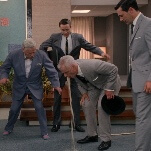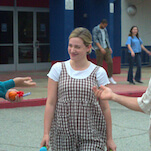It took me a second to realize these were flashbacks and not dream sequences, but I supposed it should have been obvious since this show hasn’t really employed dream sequences as a narrative device but flashbacks…well, flashbacks and flashforwards are How To Get Away With Murder’s bread and butter. But there is an undeniable dreamlike quality to these flashbacks. They’re adorned with fresh grass and bright colors and genuine smiles. Annalise sports a striking red dress in hers. In Michaela’s, rainbow trinkets wave and spin in the background. Wes talks with the other characters about normal people drama. For once, it’s almost like these kids aren’t caught up in a web of lies, broken laws, and murder. The flashbacks are a little too perfect, too. Connor opens up to Wes even though he hates Wes. Michaela offers relationship advice . Laurel and Wes look like a normal couple.
It makes for excellent television, driving a knife right through the characters’ grief, making it feel real and gutting. The flashbacks are a way for the show to emotionally process Wes’ death. They’re beautiful scenes, which is almost cruel, driving home the fact that they’re treasured moments with someone who is no longer around. Alfred Enoch is the most infectious and delightful he has ever been on the show in them, seeming more natural and loose than he usually does on the show. Every flashback snaps back to the dark present (literally—the lighting is much darker), and it’s some of the most effective time jumping the show has ever done. Because this time, the jumping around isn’t for the sake of building a mystery. It’s for putting us in the headspace of these characters. These are character-driven, emotion-driven flashbacks, not plot devices. How To Get Away With Murder can sometimes get caught up in the mechanics of crafting a twisty thriller. But that doesn’t happen in “We’re Bad People,” which is more about the emotional ramifications of Wes’ death rather than the legal ones.
While the flashbacks are the best parts of the episode, there’s other good stuff in there, too. Starting with that horror sequence in the beginning, the show doesn’t hold back in its portrayal of incarceration. Annalise’s privacy and autonomy are stripped away. I feel like a broken record when I talk about her acting, but it needs to be said that Viola Davis kills it yet again here. We don’t get the manic, vicious Annalise. Rather, she’s devastated, drained. Her cellmates are written as real people rather than mere sketches relying on stereotypes. There’s a lot of life to this episode so haunted by death.
I’ve complained in the past that How To Get Away With Murder is sometimes a little to chill about murder. There have been times when the characters seem like they’re just going through the motions of grief and trauma, taking away from the stakes. But even though their minds are on the past, every character in this episode is living fully in the present, living in their grief, their pain, their trauma. It threatens to boil over—and does in a few instances, like when Asher beats up Connor for saying he’s glad Wes is dead and when Laurel tells Frank she wishes he was dead instead of Wes. Sam’s murder is still reverberating all these episodes later, and Wes’ murder is bound to have even deeper, more lasting effects on the characters’ psyches and on the show’s scope. No one is working on figuring out how to get away with murder so much as how to move on now that everything is so spectacularly broken.
Stray observations
- Ok, so someone is probably trying to figure out how to get away with murder, but we don’t know who. The Mahoneys is perhaps too obvious of an answer, even though it is the one that makes the most sense. Frank turns himself in at episode’s end, but that final flashback also makes it seem like that would be too obvious of an answer. Plus, the structure of the episode suggests Frank is only turning himself in as a reaction to Laurel’s hurtful words and because it’s the only way to help Annalise.
- The episode’s title plays on the title of the third season premiere, which was “We’re Good People Now.”
- Here’s a little piece of sound mixing trivia from HTGAWM showrunner Peter Nowalk.
- “I loved him so much more than I ever loved you.” DAMN, LAUREL.
- “You think I’m racist, don’t you?” “I just think you’re white.” Enoch’s delivery of this is the most he has ever made me laugh on this show.









































